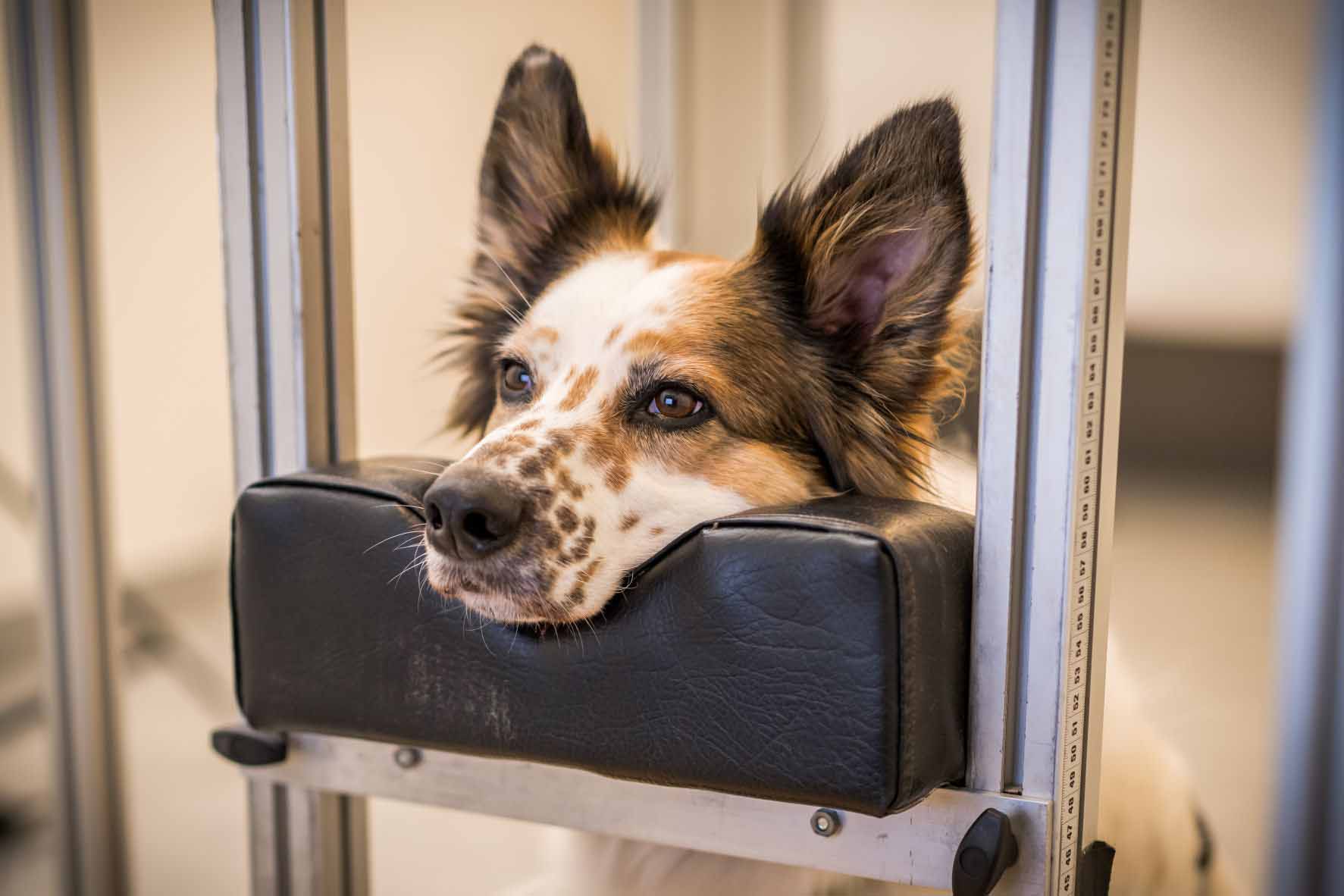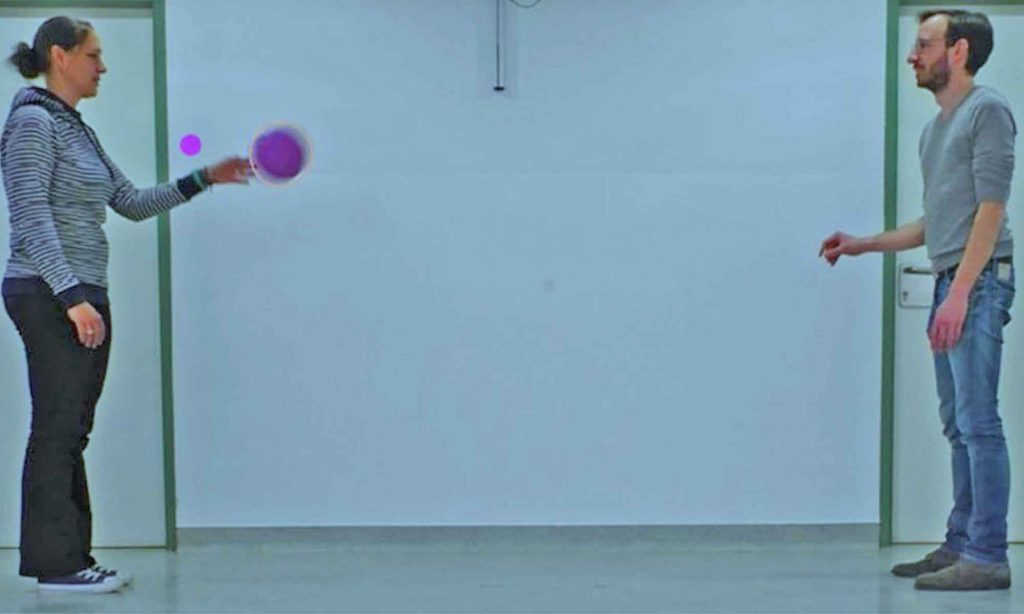
Estimated reading time: 7 minutes
Our ability to predict a moving object’s destination can be very useful. For example, predicting where a flying rock will be in a few seconds may allow us to move out of its path to avoid a terrible headache. The ability to track moving objects and predict their trajectory would clearly benefit any animal trying to survive in a complex environment – but do other animals share this skill? Many dog owners are quite familiar with their pet’s ball catching prowess, but until recently, there was no scientific evidence that dogs can in fact track an object with their eyes and anticipate its destination.
Dogs may in fact be very well adapted for processing an object’s motion and predicting its destination. Compared to human eyes, dog eyes have a higher proportion of rod cells, which are sensitive to movement. Evidence also suggests that dogs process temporal information faster than humans. Recently, Christoph Völter, Sabrina Karl, and Ludwig Huber set out to determine whether dogs, like humans, exhibit motion tracking and anticipatory-looking behavior. Uniquely, they used eye-tracking technology to specifically examine whether dogs can accurately track a moving frisbee and predict its destination.
Eye Tracking Dogs in the Lab
For the experiment, Christoph Völter and his colleagues tested pet dogs, mostly border collies but also some mixed breeds and an Australian shepherd. For each dog, an EyeLink 1000 tracked its eye movements while watching a video of two people throwing a frisbee back and forth 10 times against a white background. Below, the top picture shows a dog resting its head comfortably on a chin-rest while watching the video during an eye-tracking session. The bottom picture is a screenshot from the video with a dog’s gaze superimposed as a purple dot.


If a dog can anticipate the position of the frisbee, you would expect a period for learning the frisbee’s movement pattern. Then later, anticipation could kick in with the dog’s gaze landing on the catcher (the destination) before the frisbee. Natural stimuli, however, are rich in other information. If the dog’s gaze jumps ahead, it is possible that the catcher’s hand motion grabbed the dog’s gaze and dragged it ahead of the moving frisbee. To rule out this explanation, the experimenters periodically froze a person’s movement in the video. The video below shows a 9-second trial. You can see both the left and right individuals are frozen twice when the frisbee moves toward them for a catch. In these cases, there is no motion from the catcher to grab the dog’s gaze away from the frisbee.
Dogs and Tracking
The experimental results indicate that dogs can in fact track a moving object. In the time series plot below, the light grey shading shows the position of the individuals, whereas the dark grey bars indicate when the individuals were frozen. There is a clear overlap between the frisbee movement (red line) and the dogs’ gaze (black line; note, the dashed grey line represents each dog’s data, while the black line indicates median group data). In fact, the frisbee movement explained a large amount of the dog’s horizontal eye movements. Keep in mind, the experimenters could not give the dogs instructions to follow the movement of the frisbee. Rather, the dogs automatically fixated the frisbee and tracked its back and forth movement.

Dogs and Predicting
Is there evidence that the dogs can anticipate the frisbee’s destination after learning the pattern? To determine this, the experimenters examined the time difference between each dog’s first look at the catcher and the catcher’s first contact with the frisbee (i.e., “latency to look at the catcher”). Positive values indicated the catcher first caught the frisbee and then the dogs glanced at the catcher. Negative values indicated the opposite. The dogs, in fact, glanced at the catcher before the frisbee arrived. In other words, the dogs anticipated the location of the frisbee.
In the graph below, the dashed horizontal line shows the time point before the frisbee makes contact with the catcher. Dots are individual data points that indicate the latency to look at the catcher as a function of throw number (2-10), while the black line with the surrounding grey shading is the model (with 95% confidence interval) fit to these data points. The model shows that in the first few trials the catchers caught the frisbee before the gaze of the dogs landed on the catcher. However, that switched in the later trials. The dogs glanced at the catcher, anticipating the frisbee would be caught before it actually was. Freezing the catchers had no effect on these results.

Dogs and Unpredictable Events
To further characterize the motion tracking ability of dogs, Völter and his colleagues examined the effect of surprising motion events. For this viewing sequence (video below), the frisbee’s back and forth motion is paused and the frisbee reverses direction. Even within this less predictable environment, the frisbee movement explained a large part of the dogs’ horizontal eye movements, but to a lesser extent than in the first experiment. For the freezing and rewinding events, the first two freezing sequences appeared to capture the dogs’ attention. However, for two dogs, their gaze overshot to the next player when the video was frozen for the first time. Further, the dogs looked faster at the catcher following regular, forward movements of the frisbee compared to the unexpected backward movements. Thus, even within this unpredictable environment, some dogs were not just tracking motion, but anticipating it.
Moving Science Forward
Human object tracking ability is well documented. It is even a developmental milestone. The results from this study by Christoph Völter, Sabrina Karl, and Ludwig Huber extend motion tracking to dogs, suggesting that dogs can in fact track a fast-moving disk in the air, anticipate its destination after seeing it go back and forth a couple of times between catchers, and react to surprising events in this sequence. In addition to providing solid research to support the notion that dogs exhibit anticipatory looking behavior, this study offers new ideas to expand the comparative literature by using a new motion eye-tracking paradigm with dogs.
“Showing that dogs engage in anticipatory looking provides us with an exciting new avenue for studying how dogs process information concerning their physical and social environment.”
Dr. Christoph Völter
Contact
If you would like us to feature your EyeLink research, have ideas for posts, or have any questions about our hardware and software, please contact us. We are always happy to help. You can call us (+1-613-271-8686) or click the button below to email:

